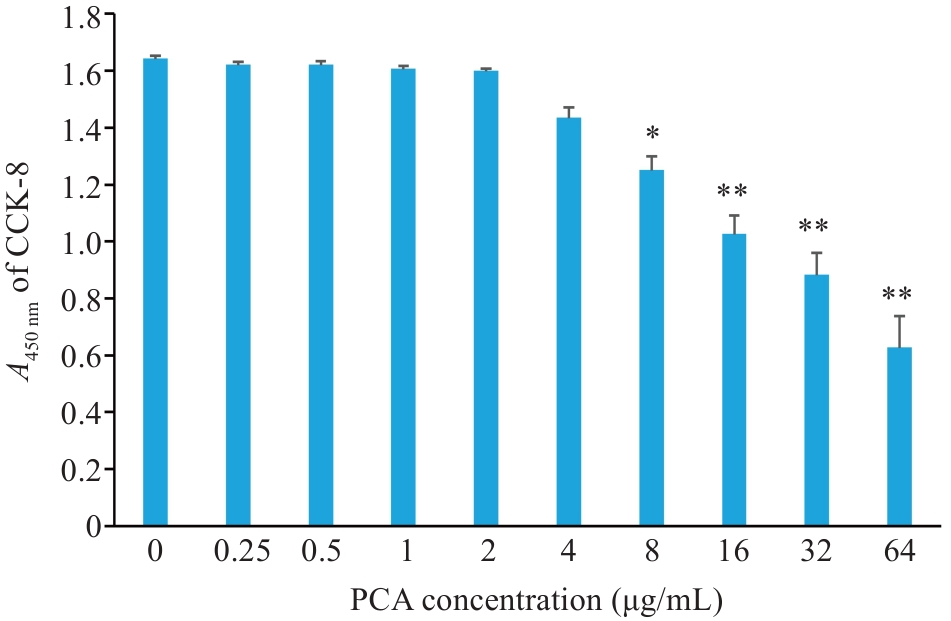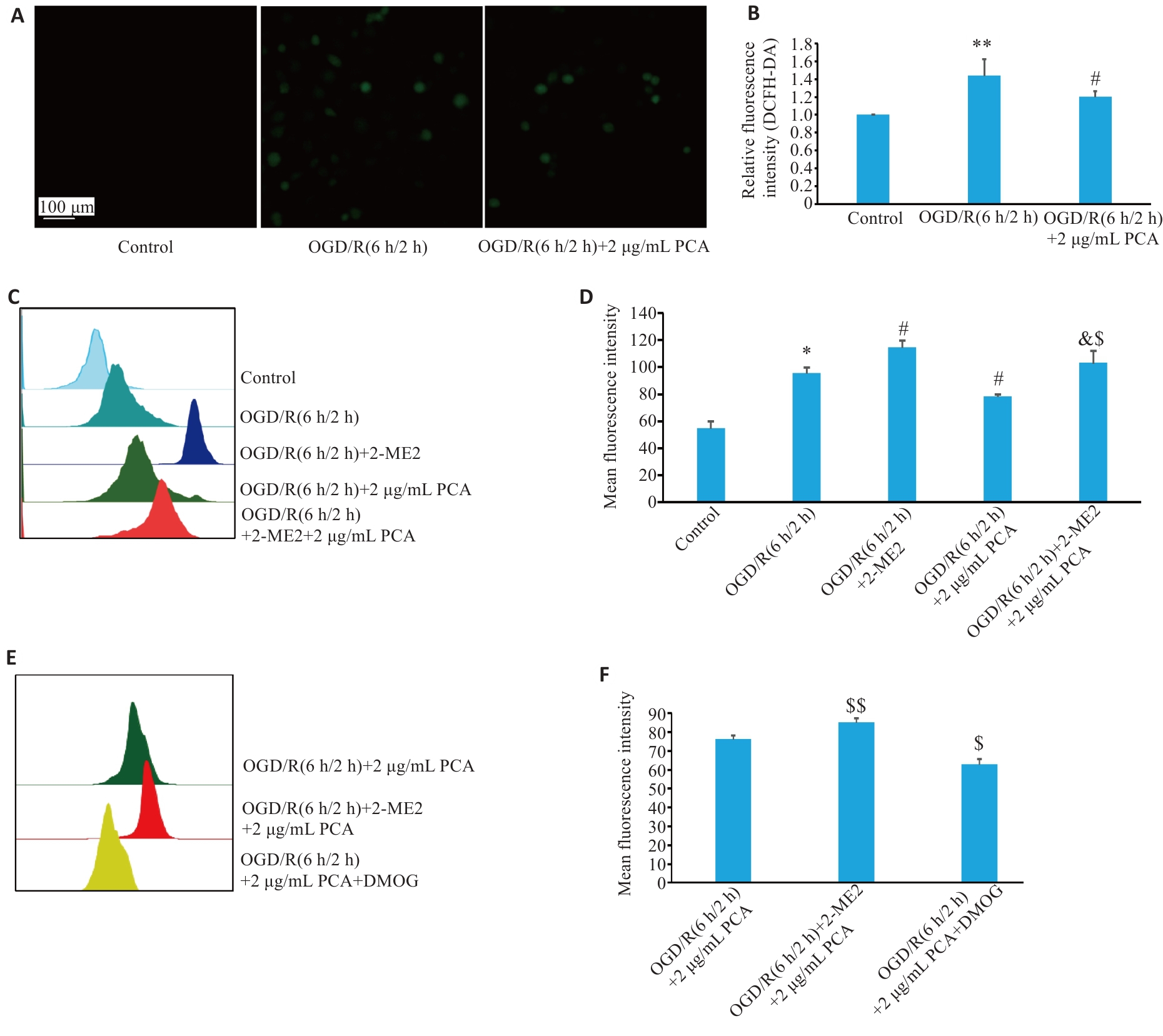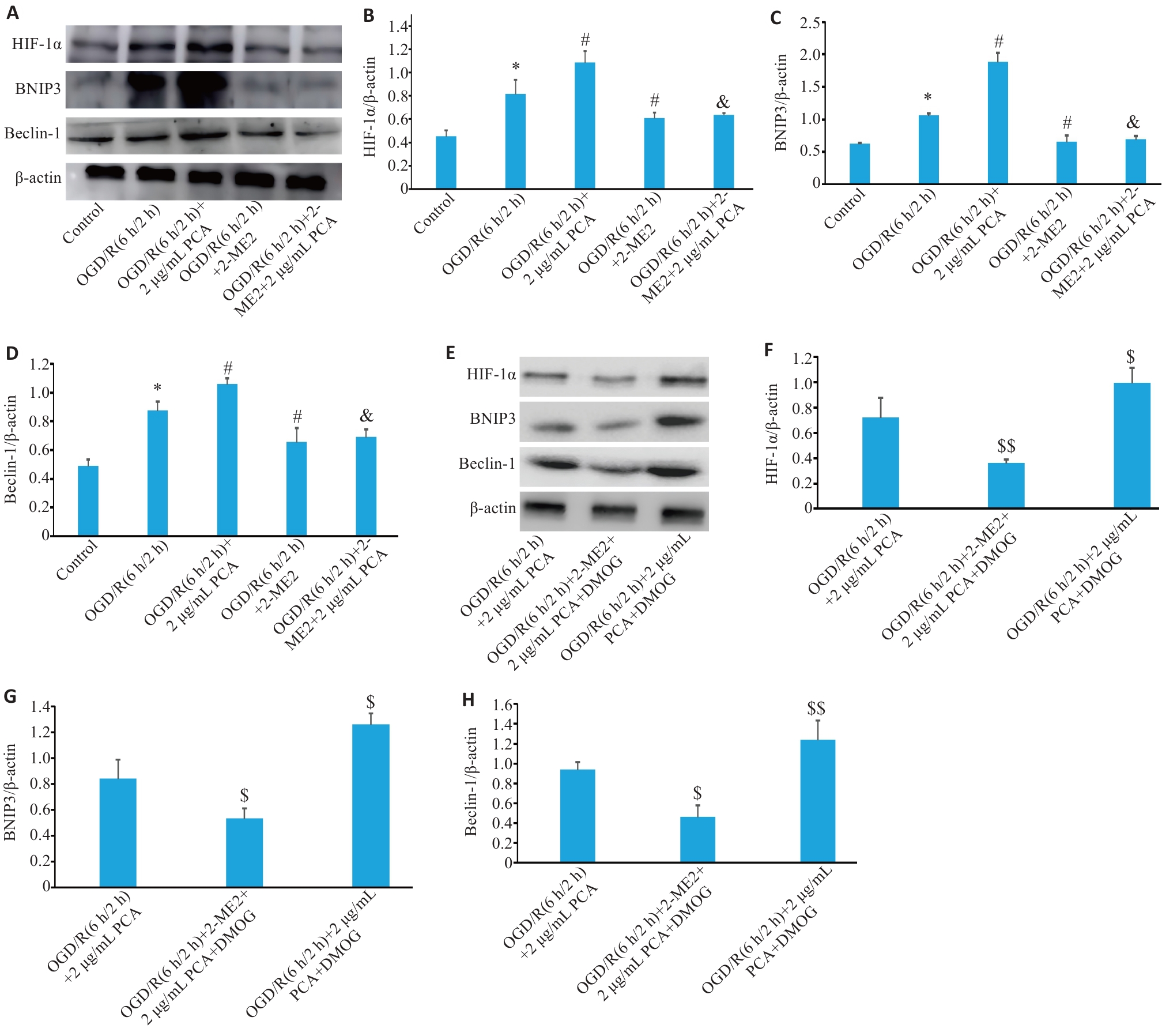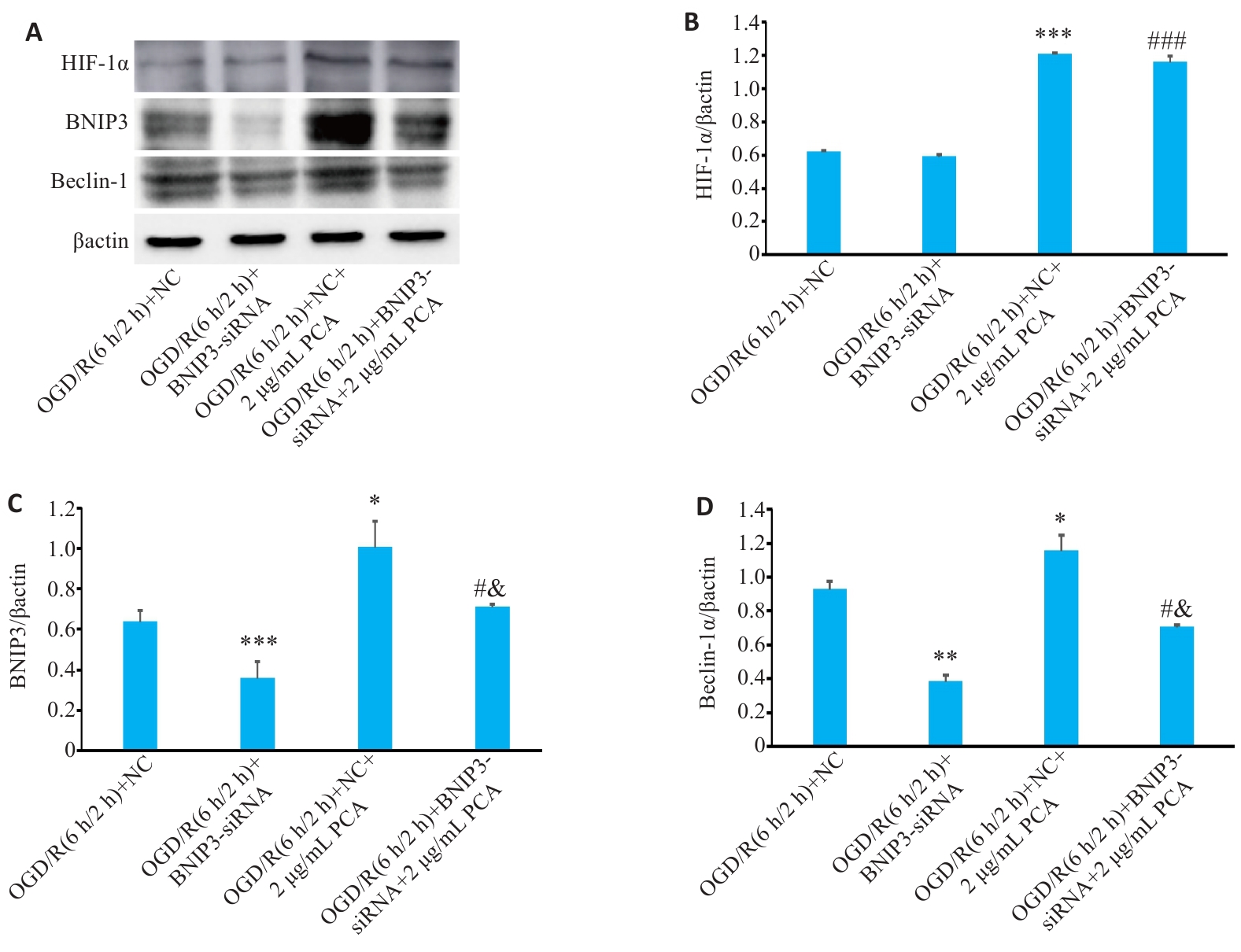Journal of Southern Medical University ›› 2025, Vol. 45 ›› Issue (3): 614-621.doi: 10.12122/j.issn.1673-4254.2025.03.19
Ming LIAO( ), Wenhua ZHONG, Ran ZHANG, Juan LIANG, Wentaorui XU, Wenjun WAN, Chao LI Shu WU
), Wenhua ZHONG, Ran ZHANG, Juan LIANG, Wentaorui XU, Wenjun WAN, Chao LI Shu WU
Received:2024-09-10
Online:2025-03-20
Published:2025-03-28
Ming LIAO, Wenhua ZHONG, Ran ZHANG, Juan LIANG, Wentaorui XU, Wenjun WAN, Chao LI Shu WU. Protein C activator derived from snake venom protects human umbilical vein endothelial cells against hypoxia-reoxygenation injury by suppressing ROS via upregulating HIF-1α and BNIP3[J]. Journal of Southern Medical University, 2025, 45(3): 614-621.
Add to citation manager EndNote|Ris|BibTeX
URL: https://www.j-smu.com/EN/10.12122/j.issn.1673-4254.2025.03.19
| Genes | F-siRNA | R-siRNA |
|---|---|---|
| BNIP3 | CCUGGGUAGAACUGCACUU TT | AAGUGCAGUUCUACCCAGG TT |
| NC | UUCUCCGAACGUGUCACGU TT | ACGUGACACGUUCGGAGA ATT |
Tab.1 siRNA oligonucleotide sequence
| Genes | F-siRNA | R-siRNA |
|---|---|---|
| BNIP3 | CCUGGGUAGAACUGCACUU TT | AAGUGCAGUUCUACCCAGG TT |
| NC | UUCUCCGAACGUGUCACGU TT | ACGUGACACGUUCGGAGA ATT |

Fig.2 Proliferative activity of the cells (presented as OD values) treated with different concentrations of protein C activator (PCA). *P<0.05, **P<0.01 vs control group.

Fig.3 Reactive oxygen species (ROS) production in the cells after treatment with PCA, 2-ME2 and DMOG. A, B: ROS staining in each group. C, D: Flow cytometry of ROS in each group (n=3). *P<0.05, **P<0.01 vs Control group; #P<0.05 vs OGD/R(6 h/2 h) group;$P<0.05, $$P<0.01 vs OGD/R(6 h/2 h) +2 μg/mL PCA group.

Fig.4 Effects of PCA, 2-ME2 and DMOG on cellular protein expressions. A: Western blotting for detecting cellular protein expressions. B-D: Grayscale values of HIF1α, BNIP3 and Beclin-1. E: Western blotting for detecting histone expression. F-H: HIF1α, BNIP3 and Beclin-1 protein expression levels (n=3). *P<0.05 vs control group; #P<0.05 vs OGD/R(6 h/2 h) group; &P<0.05 vs OGD/R(6 h/2 h) +2 μg/mL PCA group; $P<0.05, $$P<0.01 vs OGD/R(6 h/2 h)+2 μg/mL PCA group.

Fig.6 Effect of BNIP3 inhibition on expressions of HIF1α, BNIP3 and Beclin-1. A: BINP3 mRNA expression levels. B-E: Western blotting for detecting protein expression levels of HIF1α, Beclin-1 and BINP3 (n=3). *P<0.05, **P<0.01, ***P<0.001vs OGD/R (6 h/2 h)+NC group, #P<0.05, ###P<0.001 vs OGD/R (6 h/2 h)+BNIP3 siRNA group, &P<0.05 vs OGD/R (6 h/2 h)+2 μg/mL PCA group.
| 1 | Campbell B C V, Desilva D A, Macleod M R, et al. Ischaemic stroke[J].Nat Rev Dis Primers, 2019, 5(1):70. |
| 2 | Tsivgoulis G, Katsanos AH, Sandset EC, et al. Thrombolysis for acute ischaemic stroke: current status and future perspectives[J]. Lancet Neurol, 2023, 22(5): 418-29. |
| 3 | He JF, Liu DY, Zhao LX, et al. Myocardial ischemia/reperfusion injury: mechanisms of injury and implications for management (review)[J]. Exp Ther Med, 2022, 23(6): 430. |
| 4 | Babior BM, Kipnes RS, Curnutte JT. Biological defense mechanisms. The production by leukocytes of superoxide, a potential bactericidal agent[J]. J Clin Invest, 1973, 52(3): 741-4. |
| 5 | Hubert M, Stuart S, Ohh M. Glucose deprivation impairs hypoxia-inducible factor-1α synthesis[J]. Discov Oncol, 2024, 15(1): 595. |
| 6 | Wang H, Song TY, Reyes-García J, et al. Hypoxia-induced mitochondrial ROS and function in pulmonary arterial endothelial cells[J]. Cells, 2024, 13(21): 1807. |
| 7 | Fleming AM, Burrows CJ. Why the ROS matters: One-electron oxidants focus DNA damage and repair on G-quadruplexes for gene regulation[J]. DNA Repair, 2025, 145: 103789. |
| 8 | Ernster L, Schatz G. Mitochondria: a historical review[J]. J Cell Biol, 1981, 91(3 Pt 2): 227s-55s. |
| 9 | 李 益, 刘柯妤, 徐艳艳, 等. 转录因子FOXO3在心肌缺血再灌注损伤中的研究进展[J]. 中国分子心脏病学杂志, 2024, 24(3): 6173-8. |
| 10 | Mráček T, Drahota Z, Houštěk J. The function and the role of the mitochondrial glycerol-3-phosphate dehydrogenase in mammalian tissues[J]. Biochim Biophys Acta, 2013, 1827(3): 401-10. |
| 11 | 李 曙, 张根葆, 洪 云, 等. 蝮蛇毒蛋白C激活物改善急性心肌梗死大鼠心功能的机制研究[J]. 中国临床药理学与治疗学, 2012, 17(2): 141-6. |
| 12 | 李 曙, 陆晓华, 张根葆. 蝮蛇毒蛋白C激活物对大鼠在体心肌缺血再灌注损伤的干预作用[J]. 皖南医学院学报, 2008, 27(3): 167-9. |
| 13 | 张 阳, 陈 瑞, 刘 迪, 等. 蝮蛇毒蛋白C激活物对全脑缺血再灌注损伤大鼠血-脑屏障通透性的影响[J]. 中国临床药理学杂志, 2020, 36(16): 2404-7. DOI: 10.13699/j.cnki.1001-6821.2020.16.007 |
| 14 | 张 阳, 张根葆, 吴 娟. 蝮蛇毒蛋白C激活物对全脑缺血再灌注损伤大鼠血液粘度变化的影响[J]. 皖南医学院学报, 2009, 28(6): 399-401. |
| 15 | Zhu MX, Li XF, Guo J, et al. Orexin A protects against cerebral ischemia-reperfusion injury by enhancing reperfusion in ischemic cortex via HIF-1α-ET-1/ENOS pathway[J]. Brain Res Bull, 2024, 218: 111105. |
| 16 | Li ZH, Yin B, Xu YN, et al. Von Hippel-Lindau deficiency protects the liver against ischemia/reperfusion injury through the regulation of hypoxia-inducible factor 1α and 2α[J]. Hepatol Commun, 2024, 8(12): e0567. |
| 17 | Gao WH, Wang DY, Shi YM, et al. Potential cardiovascular disease treatment by natural drugs targeting the HIF-1α factor and its pathway[J]. Comb Chem High Throughput Screen, 2024. |
| 18 | Shen GL, Wang H, Zhu N, et al. HIF-1/2α‑activated RNF146 enhances the proliferation and glycolysis of hepatocellular carcinoma cells via the PTEN/AKT/mTOR pathway[J]. Front Cell Dev Biol, 2022, 10: 893888. |
| 19 | Wurm CA, Jakobs S. Differential protein distributions define two sub-compartments of the mitochondrial inner membrane in yeast[J]. FEBS Lett, 2006, 580(24): 5628-34. |
| 20 | Toulmay A, Prinz WA. Lipid transfer and signaling at organelle contact sites: the tip of the iceberg[J]. Curr Opin Cell Biol, 2011, 23(4): 458-63. |
| 21 | Li S, Mo JC, Fang YX, et al. Macrophage migration inhibitory factor facilitates replication of Senecavirus A by enhancing the glycolysis via hypoxia inducible factor 1 alpha[J]. Int J Biol Macromol, 2024, 281(Pt 1): 136197. |
| 22 | Huang YY, Yang Y, Chen XL, et al. Downregulation of malic enzyme 3 facilitates progression of gastric carcinoma via regulating intracellular oxidative stress and hypoxia-inducible factor-1α stabilization[J]. Cell Mol Life Sci, 2024, 81(1): 375. |
| 23 | Lu B, Li JH, Gui MT, et al. Salvianolic acid B inhibits myocardial I/R-induced ROS generation and cell apoptosis by regulating the TRIM8/GPX1 pathway[J]. Pharm Biol, 2022, 60(1): 1458-68. |
| 24 | Ding CG, Ding XM, Zheng J, et al. miR-182-5p and miR-378a-3p regulate ferroptosis in I/R-induced renal injury[J]. Cell Death Dis, 2020, 11(10): 929. |
| 25 | 李 曙, 张根葆, 洪 云, 等. 蛇毒PCA改善冠脉微血栓大鼠血液流变学的机制研究[J]. 中国病理生理杂志, 2012, 28(4): 595-600. DOI: 10.3969/j.issn.1000-4718.2012.04.004 |
| 26 | Zhang L, Cao YY, Guo XX, et al. Hypoxia-induced ROS aggravate tumor progression through HIF-1α-SERPINE1 signaling in glioblastoma[J]. J Zhejiang Univ Sci B, 2023, 24(1): 32-49. |
| 27 | 徐 丹, 陶 陶, 张继荣, 等. HIF-1α对脑缺血再灌注损伤细胞凋亡及凋亡相关基因的研究进展[J]. 中国神经免疫学和神经病学杂志, 2017, 24(3): 219-22. DOI: 10.3969/j.issn.1006-2963.2017.03.016 |
| 28 | Kobayashi Y, Oguro A, Imaoka S. Feedback of hypoxia-inducible factor-1alpha (HIF-1alpha) transcriptional activity via redox factor-1 (Ref-1) induction by reactive oxygen species (ROS)[J]. Free Radic Res, 2021, 55(2): 154-64. |
| 29 | Zhang C, Zhen LM, Fang ZP, et al. Adiponectin treatment attenuates cerebral ischemia-reperfusion injury through HIF-1 α-mediated antioxidation in mice[J]. Oxid Med Cell Longev, 2021, 2021: 5531048. |
| 30 | Yang N, Yang X, Fang Y, et al. Nitric oxide promotes cerebral ischemia/reperfusion injury through upregulating hypoxia-inducible factor1‑α‑associated inflammation and apoptosis in rats[J]. Neurosci Lett, 2023, 795: 137034. |
| 31 | Wang CC, Li Y, Qian XQ, et al. Empagliflozin alleviates myocardial I/R injury and cardiomyocyte apoptosis via inhibiting ER stress-induced autophagy and the PERK/ATF4/Beclin1 pathway[J]. J Drug Target, 2022, 30(8): 858-72. |
| 32 | Shao Z, Dou S, Zhu J, et al. The Role of Mitophagy in Ischemic Stroke[J]. Front Neurol, 2020, 11:608610. |
| 33 | Li SH, Jiang JM, Fang JY, et al. Naringin protects H9C2 cardiomyocytes from chemical hypoxia-induced injury by promoting the autophagic flux via the activation of the HIF-1α/BNIP3 signaling pathway[J]. Int J Mol Med, 2021, 47(6): 102. |
| Viewed | ||||||
|
Full text |
|
|||||
|
Abstract |
|
|||||